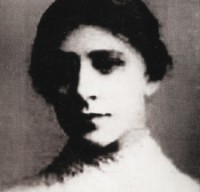
Florence Susan Harrison
Until a few years ago book illustrator Florence Harrison was listed by book and art dealers under the name of Emma Florence Harrison and biographical detail was limited to phrases such as, "little is known about this artist’s life". Then inspired by a chance find at an antiques fair book collector Mary Jacobs took up the gauntlet and set about researching the life and work of her favourite illustrator.
“I chanced upon a fine copy of “Christina Rossetti poems… The jewel-like palette of colours and the contrasting vibrancy of the illustrations which characterized her early works so entranced me that I immediately set about trying to discover more about her life.”
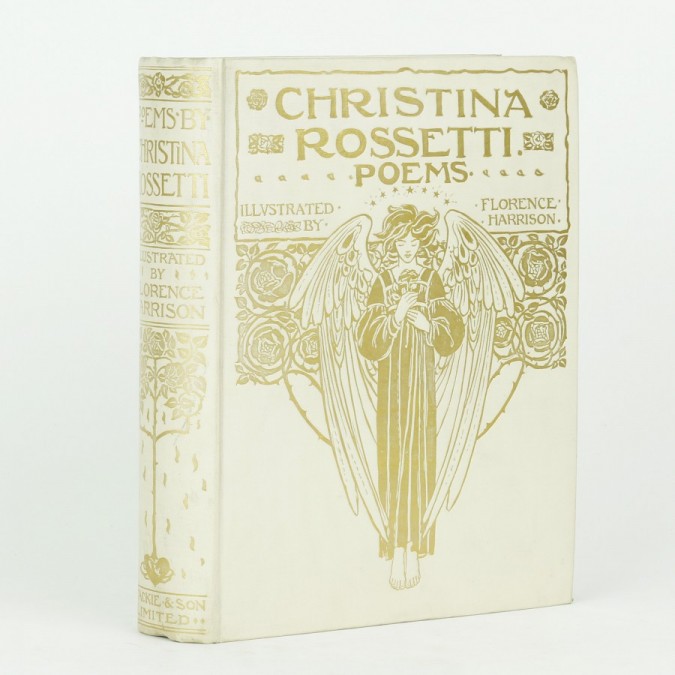
Christina Rossetti's Poems with Florence Harrison's illustrations
Mary’s research began by tracing the history of Emma Florence Harrison, who was known to have exhibited at the Royal Academy in 1887, she successfully traced Emma Florence Harrison’s history and launched a website telling the story of the artist’s life. Coincidentally a short time later a retired lady in Sydney, Australia had purchased her first computer and “googled” her Great Aunt Florrie. She came across Mary’s website describing the life of Florence Harrison and realised there was a case of mistaken identity. Her Great Aunt Florrie was not Emma Florence, but Florence Susan Harrison. Florence’s great niece and Mary Jacobs pooled their information and were able to piece together much about an artist whose background had been a mystery for so long.
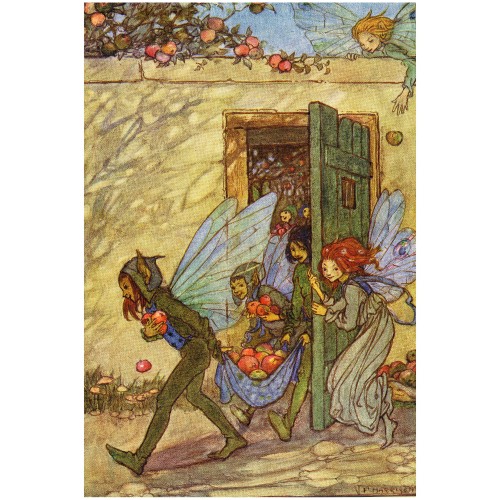
Frontispiece from Florence Harrison's Elfin Song
Florence Susan Harrison (known to surviving family as Aunt Florrie) was born in Brisbane, Australia in 1877. Her father was a sailor and Florence spent much of her early childhood on board ships. In between voyages she attended a school in Folkestone, England which was run by a family member.
Most of Florence Harrison's book illustrations were published by Blackie and son. She wrote and illustrated a number of books of verse, on a fairy theme, Rhymes and Reasons (1905), Rhyme of a Run (1907), In the Fairy Ring (1908) and Elfin Song (1912). Her drawings are vibrant, richly coloured and characterized by a strong black outline around the figures.
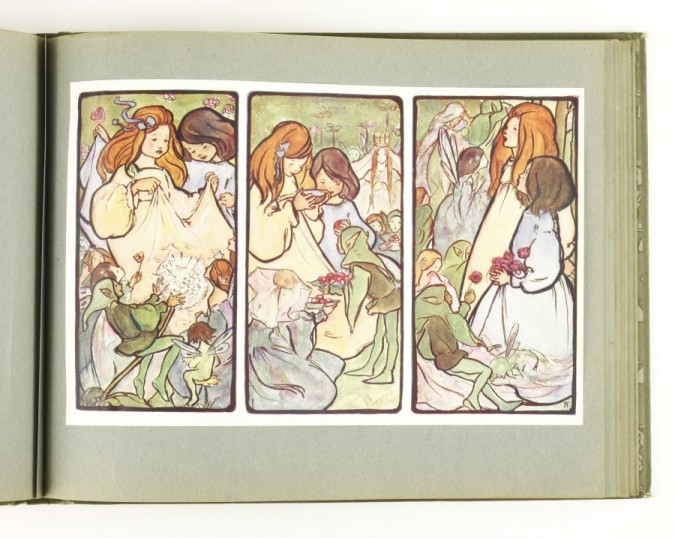
An Illustration to Rhyme of a Run
Among Florence Harrison's most sumptuous books are three volumes of poetry commissioned by Blackie as Christmas Gift Books. Christina Rossetti's Poems (1910), Tennyson's Guinevere (1912) and The Early Poems of William Morris (1913). In these volumes Harrison's use of deep colours and Art Nouveau style drawings are shown to their best advantage. 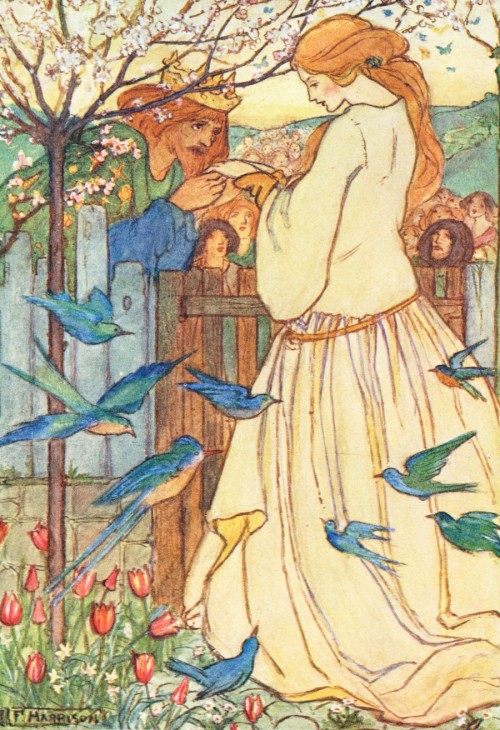
Illustration from Poems of Christina Rossetti
In my first year as a bookseller I acquired a copy of Tennyson’s Guinevere illustrated by Florence Harrison and for the first time in my life a book made my stomach flutter and raised the hairs on the back of my neck. The Art Nouveau cover with its beautiful gold tooled decoration, gave a hint of the delights within. The endpapers were decorated with simple, but stylish line drawings; the text adorned with stylised drawings in sinuous, curvy lines and the colours were deep and rich, filled with Pre-Raphaelite style maidens and dashing knights.
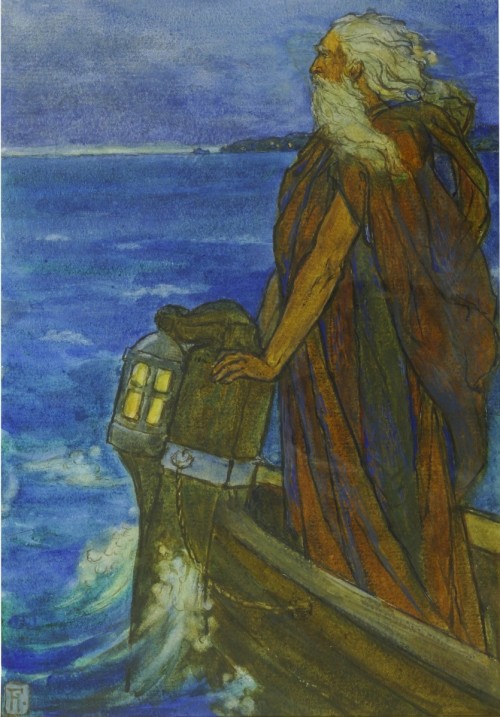
Ulysses, From Tennyson's Guinevere and Other Poems
I was smitten by the book and the artist’s work and for over a decade I endeavoured to locate Harrison’s original drawings, to no avail. I will never forget the day in 2004 when a Christies catalogue containing artwork from the estate of James W. Murray, art editor and design manager of Blackie and Son, landed on my desk. It contained page after page of paintings by Florence Harrison, all of which had been stored in folders by Murray and was in fresh, bright condition. When the sale came along it soon became evident that I was not the only person keen to obtain some of Harrison’s paintings, the lots were hotly contested and were bought by multiple bidders. Some of the paintings have now begun to circulate once more and we are delighted to be able to offer some of them for sale.
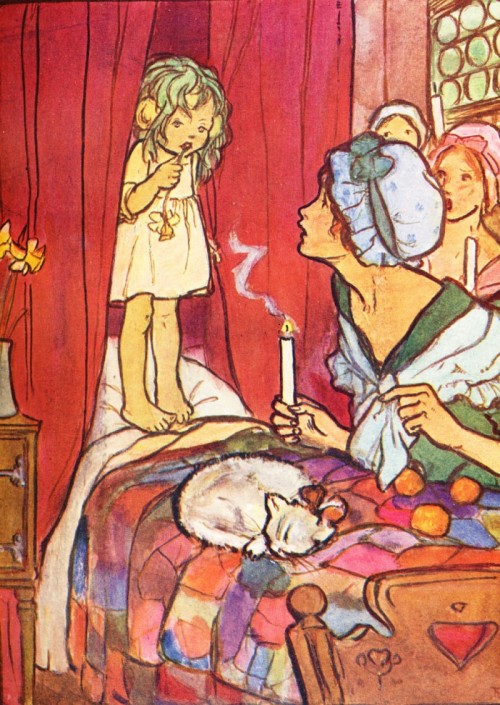
More books, paintings and prints by Florence Harrison can be browsed here.
Mary Jacob's fascinating account of her research and findings can be seen on her own website florenceharrison.com.
Further reference
"Florence Harrison: A Case of Mistaken Identity" by Sandy Hargrove
Comments
Recent Posts
- The Evolution of Crime
- Tour The Bookshop On Your Screen
- The Genesis of Mr. Toad: A Short Publication History of The Wind In The Willows
- Frank Hurley's 'South'
- The "Other" Florence Harrison
- Picturing Enid Blyton
- Advent Calendar of Illustration 2020
- Depicting Jeeves and Wooster
- Evelyn Waugh Reviews Nancy Mitford
- The Envelope Booklets of T.N. Foulis
- "To Die Like English Gentlemen"
- Kay Nielsen's Fantasy World
- A Brief Look at Woodcut Illustration
- The Wealth Of Nations by Adam Smith
- What Big Stories You Have: Brothers Grimm
- Shackleton's Antarctic Career
- Inspiring Errol Le Cain's Fantasy Artwork
- Charlie & The Great Glass Elevator
- Firsts London - An Audio Tour Of Our Booth
- Jessie M. King's Poetic Art, Books & Jewellery
Blog Archive
- January 2024 (1)
- January 2023 (1)
- August 2022 (1)
- January 2022 (1)
- February 2021 (1)
- January 2021 (1)
- December 2020 (1)
- August 2020 (1)
- July 2020 (2)
- March 2020 (3)
- February 2020 (2)
- October 2019 (2)
- July 2019 (2)
- May 2019 (1)
- April 2019 (1)
- March 2019 (2)
- February 2019 (1)
- December 2018 (1)
- November 2018 (1)
- October 2018 (2)
Ann Quigley 15/Aug/2023 14:13
Hi,It was lovely to read how you feel seeing Florence’s work,I feel the same,I am an artist,I have great interest in the whole genre of fairies,but the books with the gold embossed gold covers ,and the lavishness make it very special,many women don’t even have an illustrations by credit,recently I discovered Rosie M MPitman ,She was a preraphalite artist,then,a copy of Undine ,in which she did all the illustrations,beautiful,original,this came before Arthur Rackmans Undine,and bears more than a passing resemblance to Rosie s work,
She illustrated many books ,shethen got married and stopped her career,I only found out she was born in Prestwich ,Manchester,,I live here and no one knows of Rosie,sorry for the length of this,just seems such a shame it’s taken women hundred years since to be fully appreciated,men had a 4,000 year lead,it is well known men sometimes took the credit for the wife’s work,Andrew Laing for example,fairy tales the,selves have been around in one shape or another but nothing surpasses the golden age 1900 to 1945,
Sincerely Ann Quigley
Meem Akbar 24/May/2023 01:38
I met Florence in the 70’s as a teacher with ken Jeffers who taught us “when we are laughing at some jokes, we’re laughing at ourselves” Wow, my appreciation to you and your brother for the love shared.🗽🕰
Sam Jonkers 03/Feb/2021 14:39
Helen, Take a look at Mary Jacob's site, as per the link above. She traced the life of Emma Florence Harrison (FEH). Keep an eye on our blog for more on this soon. :)
Helen Adair Macgregor 03/Feb/2021 13:45
To conclude my comments. After many years, and finding little evidence to the contrary, I had come also to the inevitable conclusion that there were two artists. This " agreement" should also be addressed in any published information and acknowledged in any future literature. The usual terminology " The real Florence Harrison". is incorrect surely both Florence Susan Harrison of Blackie publications and Florence Emma Harrison of the A. Vivian Mansell publications were both "Real" Florence Harrisons. Ladies who , worked with similar subjects around the same time. They also coincidentally had almost the same style of initials which are hard to tell apart. This latter fact, along with the knowledge that postcard publishers of the time frequently drew from book publication works, caused me to stick with the one artist theory for many years. There are also some very similar illustrations , however unless someone can find more from the A. Vivian Mansell archives, little will ever be known about Florence Emma, other than it wss she who exhibited at R.A.
Regards Helen
Helen Adair Macgregor 03/Feb/2021 02:05
Thank you for your response to my previous comment. I am so glad to receive your agreement that there were two artists of similar names. The FEH signed postcards published byA.Vivian Mansell were in two sets of six with Arts & Crafts borders. One set are children and the other Fairies( Hendry the confusion). I would add that although they are very pretty they are not at all like the beautiful work of Florence ( Susan) Harrison who illustrated for Blackie
Jonkers Rare Books 01/Feb/2021 13:25
Hi Helen,
There are indeed two artists, Florence Harrison the book illustrator and Florence Emma Harrison the artist who people mistakenly assumed the book illustrations were by.
Helen Adair Macgregor 01/Feb/2021 11:53
I became involved in this controversy many years ago when I was selling some of the lovely Arts & Crafts bordered postcards initialed F.E.H. One elderly postcard enthusiast had done some quite a bit of research and found the Florence Emma Harrison who exhibited in London and who was " influenced by William Morris. Later the decendent of Florence Susan Harrison gave the information about her aunt. I have seen the lovely work attributed to " Florence Harrison" and do not think it is by the same artist who signs FEH. However this controversy seemed to dismiss the FEH artist as if she never existed and I feel that there must be Two artists not just a mistaken identity
Natasha Suzanne Jupp 12/Feb/2017 16:18
Very, very similar to Arthur Rackham about the same time period too. Beautiful illustrations